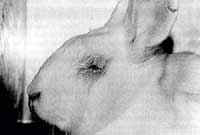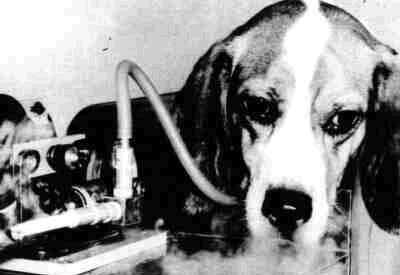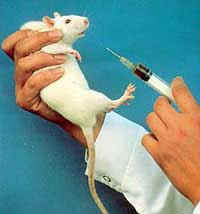Eye Irritancy Tests
In these tests, a liquid, flake, granule, or powdered substance is dropped
into the eyes of a group of albino rabbits. The animals are often immobilized
in stocks from which only their heads protrude. They usually receive no
anesthesia during the tests.
| After placing the substance in the rabbits' eyes, laboratory technicians
record the damage to the eye tissue at specific intervals over an average
period of 72 hours, with tests sometimes lasting 7 to 18 days. Reactions to
the substances include swollen eyelids, inflamed irises, ulceration, bleeding,
massive deterioration, and blindness. During the tests, the rabbits' eyelids
are held open with clips. Many animals break their necks as they struggle to
escape. |
 |
 |
The results of eye irritancy tests are questionable, as they vary from
laboratory to laboratory-and even from rabbit to rabbit. |
Acute Toxicity Tests
Acute toxicity tests, commonly called lethal dose or poisoning tests,
determine the amount of a substance that will kill a percentage, even up to
100 percent, of a group of test animals.
 |
|
In these tests, a substance is forced by tube into the animals' stomachs or
through holes cut into their throats. It may also be injected under the skin,
into a vein, or into the lining of the abdomen; mixed into lab chow; inhaled
through a gas mask; or introduced into the eyes, rectum, or vagina.
Experimenters observe the animals' reactions, which can include convulsions,
labored breathing, diarrhea, constipation, emaciation, skin eruptions,
abnormal posture, and bleeding from the eyes, nose, or mouth.(1) |
The widely used lethal dose 50 (LD50) test was developed in 1927. The LD50
testing period continues until at least 50 percent of the animals die, usually
in two to four weeks.
Like eye irritancy tests, lethal dose tests are unreliable at best. Says
Microbiological Associates' Rodger D. Curren, researchers looking for
non-animal alternatives must prove that these in vitro models perform "at
least as well as animal tests. But as we conduct these validation exercises,
it's become more apparent that the animal tests themselves are highly
variable."(2) The European Center for the Validation of Alternative
Methods' Dr. Michael Ball puts it more strongly: "The scientific
basis" for animal safety tests is "weak."(3)
Lethal But Legal
No law requires animal testing for cosmetics and household products. The
Food and Drug Administration (FDA) requires only that each ingredient in a
cosmetics product be "adequately substantiated for safety" prior to
marketing or that the product carry a warning label indicating that its safety
has not been determined. The FDA does not have the authority to require any
particular product test. Likewise, household products, which are regulated by
the Consumer Product Safety Commission (CPSC) the agency that administers the
Federal Hazardous Substances Act (FHSA) do not have to be tested on animals. A
summary of the CPSC's animal-testing policy, printed in the Federal Register,
states, "[I]t is important to keep in mind that neither the FHSA nor the
Commission's regulations require any firm to perform animal tests. The statute
and its implementing regulations only require that a product be labeled to
reflect the hazards associated with that product."(4)
Testing methods, therefore, are determined by manufacturers. The very
unreliability of animal tests may make them appealing to some companies, since
these tests allow manufacturers to put virtually any product on the market.
Companies can also use the fact that their products were tested to help defend
themselves against consumer lawsuits. Others believe that testing on animals
helps them compete in the marketplace: Consumers demand products with exciting
new ingredients, such as alpha-hydroxy acids, and animal tests are often
considered the easiest and cheapest way to "prove" that new
ingredients are "safe."
Alternatives to Animal Tests
Such arguments carry little weight with the more than 500 manufacturers of
cosmetics and household products that have shunned animal tests. These
companies take advantage of the many alternatives available today, including
cell cultures, tissue cultures, corneas from eye banks, and sophisticated
computer and mathematical models. Companies can also formulate products using
ingredients already determined to be safe by the FDA. Most cruelty-free
companies use a combination of methods to ensure safety, such as maintaining
extensive databases of ingredient and formula information and employing in
vitro tests and human clinical studies.
Tom's of Maine went one step further. For seven years, the cruelty-free
company petitioned the American Dental Association (ADA) to grant its seal of
approval to Tom's of Maine toothpastes. Other toothpaste companies
unquestioningly conducted lethal tests on rats in order to be eligible for the
ADA seal (researchers brush rats' teeth for more than a month, then kill the
animals and examine their teeth under a microscope). But Tom's of Maine worked
with researchers to develop fluoride tests that could safely be conducted on
human volunteers. The ADA finally accepted the results of these tests and
granted its seal to several of the company's toothpastes in 1995.(5) The
groundbreaking effort by Tom's of Maine to find a humane alternative to
accepted-but cruel-practices sets a precedent that other manufacturers can
follow in the future.
Compassion in Action
Caring consumers also play a vital role in eliminating cruel test methods.
Spurred by public outrage, the European Union (EU) proposed banning cosmetics
tests on animals by 1998; unfortunately, the EU has indefinitely delayed this
ban because of complaints by animal-testing companies. But other organizations
in Europe have stepped in. For example, after conducting surveys showing that
four out of five of its customers are against testing cosmetics and household
products on animals, the Co-op, Britain's largest retailer, launched its own
campaign urging companies to end such tests.
In the United States, a survey by the American Medical Association found
that 75 percent of Americans are against using animals to test cosmetics.(6)
Hundreds of companies have responded by switching to animal-friendly test
methods. To help consumers identify products that are truly cruelty-free, a
coalition of national animal protection groups has developed the Corporate
Standard of Compassion for Animals, which clarifies the non-animal- testing
terminology and procedures used by manufacturers and makes available a
cruelty-free logo for companies that are in compliance with the standard.
Shoppers can support this initiative by purchasing products that comply with
the corporate standard and boycotting those that don't and by asking local
stores to carry cruelty-free items.
References
- Rowan, A.N. Of Mice, Models, & Men: A Critical Evaluation of Animal
Research (Albany: State University of New York Press, 1984).
- Branna, Tom, "Animal Testing Alternatives: Moving Closer to
Validation?" happi, February 1995.
- Ibid.
- Federal Register, Vol. 49, No. 105.
- Ahrens, Frank, "Why Is This Rat Smiling?" The Washington
Post, August 17, 1995.
- Branna.



